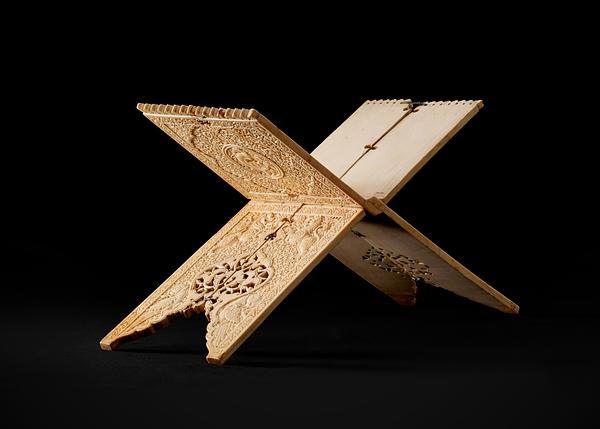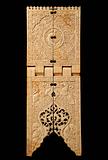In the Islamic world, books were traditionally read while seated on the floor or on a pillow. A low, X-shaped stand like this one allowed the reader to have the book lying open in front of them. Preserved stands of the same shape are known from many places including Turkey, Iran and the Mughal Empire (
10/1982), and they also appear in Islamic book painting from an early date (see, for example,
4/1997).
While the type of object is in itself almost universal in the Islamic world, the finely carved reliefs and openwork decorations on this unique ivory stand are unusual, testifying to the Deccan artists’ special penchant for mixing Islamic shapes and vegetal ornamentation with figural motifs borrowed from Hinduism. The background decorations on the upper and lower half of the stand thus consist of spiralling vines with flower heads and split leaves inspired by Timurid art from fourteenth and fifteenth-century Iran and Central Asia.
The large openwork sections on the lower half of the stand also show swelling arabesques of an older Middle Eastern design known from, for example, Koran stands from Anatolia.
[1] However, the centre of the upper half of the stand shows a pearl-studded goose or swan, a motif taken directly from Hindu mythology. Known as a
hamsa, this aquatic bird serves, among other things, as a mount for the Hindu god Brahma.
[2] On the lower half of the stand are two lions facing each other, their mouths open and forepaws raised. These lions, with their demon-like faces, layered manes, and bodies adorned with vegetal designs are classic examples of the fabulous beast known as the
yali, which frequently appears in Hindu temple architecture. In the Deccan sultanates, the
yali was used as a symbol of power and can be found on many gate vaults in cities such as Bidar and Golconda.
[3] Similar lions are also featured in designs on many smaller objects, including weapons (see, for example,
36/1997).
The stand is composed of two halves, each of which consists of two interwoven but movable plates. The two halves were formerly held together by small, carved, figure-of-eight-shaped ivory pieces, later replaced by wood and silver wire.



